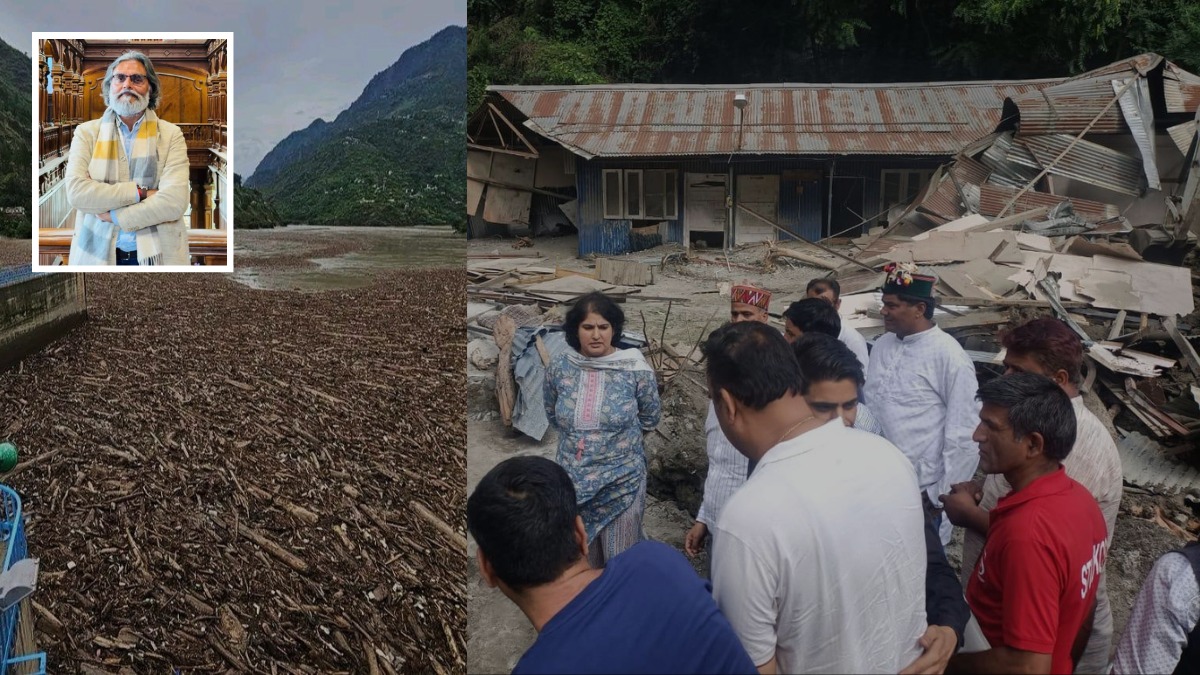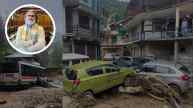The relentless torrential rain and dramatic cloud bursts in Sainj and Gadsa, nestled in the picturesque Kullu valley, have unleashed devastating floods that have ravaged the landscape. Rivers swelled, carrying away tonnes of timber, reminiscent of the chaotic scenes in the latest Allu Arjun blockbuster, Pushpa, which has taken the nation by storm during this pre-monsoon season.
In the wake of this turmoil, a significant segment of the state government has expressed their belief that the wooden logs accumulating in the Pandoh Dam are merely natural debris from the forest, swept downstream by a surge fueled by the cloudburst, not remnants of any recent illegal logging operations. Despite this assertion, residents remain skeptical. Upon closer inspection, the logs drifting in the dam appear suspiciously like they have been deliberately cut and stockpiled for an extended period. Many logs are dried and neatly sized, raising concerns about their origin. Kuldeep Singh Rathore, an MLA from the ruling Congress Party, has called a press conference, demanding clarity on the illicit felling of trees and questioning how such an activity could evade detection in the valley. Meanwhile, the Conservator of Forests in Kullu, alongside the Vice President of the HP State Forest Development Corporation, Kehar Singh Khachi, reported after initial inspections that they found no evidence to support claims of illegal logging.
Following the disaster, Deputy Commissioner of Kullu, Torul S. Raveesh, took swift action, visiting the flood-affected areas and issuing an urgent advisory to residents and visitors to maintain a safe distance from rivers, nallahs, and other hazardous spots. For those planning trips to the hills during the monsoon season, she stressed the importance of careful planning and caution.
On June 26, the Deputy Commissioner revisited the regions hardest hit by the floods, primarily caused by the overflowing Jeeva Nalah due to the extreme rainfall and subsequent cloud bursts. During her visit, she instructed officials to organize temporary shelters for displaced families and ensure that immediate financial assistance was made available.
In response to the ongoing threat, Red and Orange Alerts have been issued across several districts, including Shimla, Kangra, Mandi, Solan, Sirmaur, Kullu, Chamba, Una, Bilaspur, and Hamirpur. These alerts warn of additional heavy to very heavy rainfall and the potential for flash floods, prompting concern for local communities.
Every year, regions like Shimla and Kullu experience the unrelenting fury of nature. The combination of reckless construction and the delicate balance of the Himalayan ecosystem is increasingly strained, making it more challenging to withstand the monsoon’s onslaught and other natural disasters.
Local authorities, along with the National Disaster Response Force (NDRF), State Disaster Response Force (SDRF), and Home Guards, are actively engaged in rescue operations, saving stranded individuals, clearing blocked roads, and ensuring vital connectivity remains intact. The risks associated with more cloudbursts, flash floods, and landslides are alarmingly high, especially in areas adjacent to rivers, steep slopes, and near hydropower projects. The River Beas and its tributaries rage with fierce currents due to the relentless downpour, with persistent dangers of landslides threatening national highways in the near future as the monsoon season is just beginning.
Few Tips for Travellers to the Hills During the Monsoon
1. Plan your travels by studying the weather forecast.
2. Avoid traveling to the hills during the rainy season if possible.
3. Be prepared for certain challenges if you’re traveling in electric vehicles, such as power drain or lack of convenient charging options and backup.
4. Stay away from rivers and nallahs, and remain vigilant about the possibility of landslides.
5. Check your tires and ensure the pressure is adequate.
6. Keep essential medicines and a first aid kit on hand.
The Kirtapur-Manali NH 21 generally runs smoothly; however, there are several trouble spots, particularly at Pandoh, where landslides are a common occurrence during the rainy season. Travelers should exercise caution at the entrances and exits of the tunnels, as landslides can occur in these areas. From Aut to Kullu, several fragile hills may cave in at any moment. The road from Kullu to Manali also experiences disruptions at various points, particularly near Raison, 15 Mile, Kalatah, and close to Manali. In addition to rainfall, traffic congestion can further complicate travel conditions. If you are headed towards Sainj or Banjar, be prepared for unexpected adventures. The road to Manikaran, particularly around and beyond Kasol, is in deplorable condition.
If you look at the, monthly forecast for July released by India Meteorological Department
“Rainfall over India – Monthly average rainfall over the country as a whole in July 2025 is most likely to be above normal, exceeding 106% of the Long Period Average (LPA). Geographically, most parts of the country are likely to experience normal to above-normal rainfall. However, most parts of Northeast & East India, and many areas of extreme South Peninsular India and some areas of Northwest India, are likely to receive below-normal rainfall.”
In light of these ongoing challenges, Chief Minister Sukhvinder Singh Sukhu has mandated that district officials remain on high alert around the clock, prioritizing early warning systems, distribution of relief materials, and prompt evacuations when necessary.











